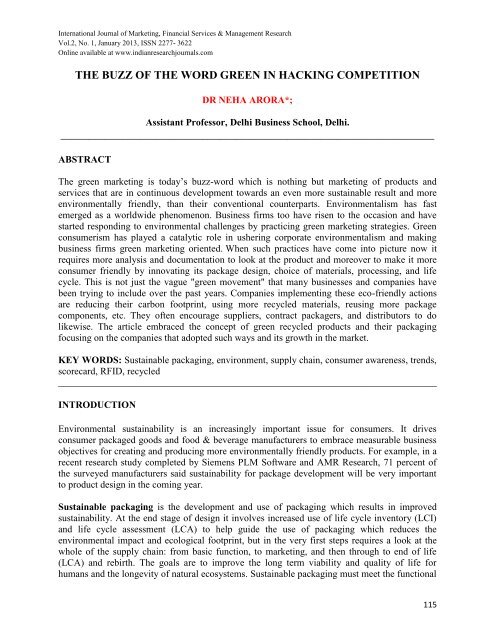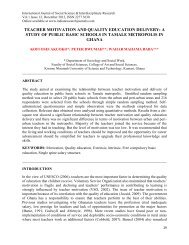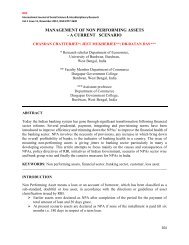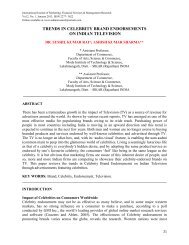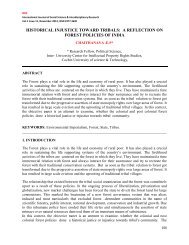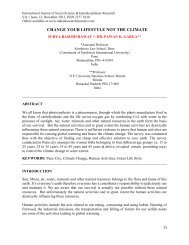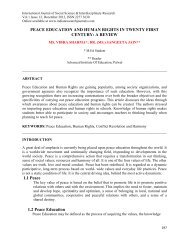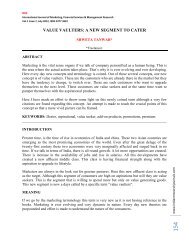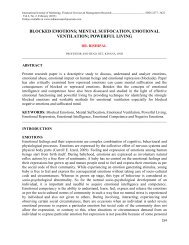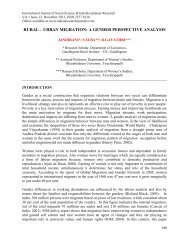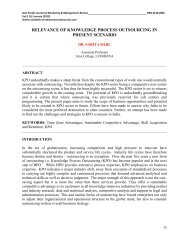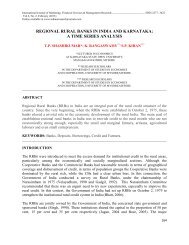THE BUZZ OF THE WORD GREEN IN HACKING COMPETITION
THE BUZZ OF THE WORD GREEN IN HACKING COMPETITION
THE BUZZ OF THE WORD GREEN IN HACKING COMPETITION
Create successful ePaper yourself
Turn your PDF publications into a flip-book with our unique Google optimized e-Paper software.
International Journal of Marketing, Financial Services & Management Research<br />
Vol.2, No. 1, January 2013, ISSN 2277- 3622<br />
Online available at www.indianresearchjournals.com<br />
<strong>THE</strong> <strong>BUZZ</strong> <strong>OF</strong> <strong>THE</strong> <strong>WORD</strong> <strong>GREEN</strong> <strong>IN</strong> HACK<strong>IN</strong>G <strong>COMPETITION</strong><br />
DR NEHA ARORA*;<br />
Assistant Professor, Delhi Business School, Delhi.<br />
__________________________________________________________________<br />
ABSTRACT<br />
The green marketing is today‟s buzz-word which is nothing but marketing of products and<br />
services that are in continuous development towards an even more sustainable result and more<br />
environmentally friendly, than their conventional counterparts. Environmentalism has fast<br />
emerged as a worldwide phenomenon. Business firms too have risen to the occasion and have<br />
started responding to environmental challenges by practicing green marketing strategies. Green<br />
consumerism has played a catalytic role in ushering corporate environmentalism and making<br />
business firms green marketing oriented. When such practices have come into picture now it<br />
requires more analysis and documentation to look at the product and moreover to make it more<br />
consumer friendly by innovating its package design, choice of materials, processing, and life<br />
cycle. This is not just the vague "green movement" that many businesses and companies have<br />
been trying to include over the past years. Companies implementing these eco-friendly actions<br />
are reducing their carbon footprint, using more recycled materials, reusing more package<br />
components, etc. They often encourage suppliers, contract packagers, and distributors to do<br />
likewise. The article embraced the concept of green recycled products and their packaging<br />
focusing on the companies that adopted such ways and its growth in the market.<br />
KEY <strong>WORD</strong>S: Sustainable packaging, environment, supply chain, consumer awareness, trends,<br />
scorecard, RFID, recycled<br />
______________________________________________________________________________<br />
<strong>IN</strong>TRODUCTION<br />
Environmental sustainability is an increasingly important issue for consumers. It drives<br />
consumer packaged goods and food & beverage manufacturers to embrace measurable business<br />
objectives for creating and producing more environmentally friendly products. For example, in a<br />
recent research study completed by Siemens PLM Software and AMR Research, 71 percent of<br />
the surveyed manufacturers said sustainability for package development will be very important<br />
to product design in the coming year.<br />
Sustainable packaging is the development and use of packaging which results in improved<br />
sustainability. At the end stage of design it involves increased use of life cycle inventory (LCI)<br />
and life cycle assessment (LCA) to help guide the use of packaging which reduces the<br />
environmental impact and ecological footprint, but in the very first steps requires a look at the<br />
whole of the supply chain: from basic function, to marketing, and then through to end of life<br />
(LCA) and rebirth. The goals are to improve the long term viability and quality of life for<br />
humans and the longevity of natural ecosystems. Sustainable packaging must meet the functional<br />
115
International Journal of Marketing, Financial Services & Management Research<br />
Vol.2, No. 1, January 2013, ISSN 2277- 3622<br />
Online available at www.indianresearchjournals.com<br />
and economic needs of the present without compromising the ability of future generations to<br />
meet their own needs.<br />
Embracing sustainability business objectives also is good for business. A recent<br />
PricewaterhouseCoopers study draws a correlation between sustainability practices and corporate<br />
performance. When comparing companies that report through a sustainability index against those<br />
that do not, “…the facts show that sustainable companies outperform non-sustainable companies<br />
on a number of key financial measures.”<br />
In addition to the consumer demand for “green” products, other pressures are driving today‟s<br />
business sustainability objectives, including:<br />
• Government regulations. There has been a 300 percent increase in climate change regulation<br />
in the last 5 years.<br />
• Retailer influence. Safeway is going solar. Tesco is testing the use of “carbon labels” on its<br />
own label products and Wal-Mart is pushing 60,000 global suppliers to find more efficient<br />
packaging methods.<br />
• Raw material shortages. Industry is dependent on rapidly depleting feed stocks such as oil<br />
and gas. Validating and sourcing substitutes has taken on increasing importance.<br />
Driving Force for company’s Shift to Sustainable Packaging<br />
If we go through the deep analysis of the market expensive and exotic packaging is a huge part<br />
of modern consumerism. Manufacturers know that many purchasing decisions we make are<br />
based on the attractiveness of good packaging. This means they are prepared to spend a lot of<br />
time and money creating eye-catching designs that will stand out from the crowd.<br />
However there is a heavy cost to this process. Although packaging is useful it does account for<br />
millions of tons of waste every year. Some of this is recycled but the majority of it does go<br />
straight to landfill. This is a huge waste of vital environmental resources.<br />
As we become more aware of our impact on the environment the high costs of packaging is<br />
becoming a major issue. A large number of consumers are now actively choosing the more ecofriendly<br />
alternative when they shop by opting for packaging that can be recycled. This means<br />
that for manufacturers it is now more possible than ever to take a “greener” approach to<br />
packaging whilst still meeting their marketing objectives. The new trend in sustainable<br />
packaging is rapidly growing and spreading throughout the food, clothing and general goods<br />
markets.<br />
Sustainable packaging is designed to reduce wastage and conserve important resources. There<br />
are three main elements to this:<br />
116
International Journal of Marketing, Financial Services & Management Research<br />
Vol.2, No. 1, January 2013, ISSN 2277- 3622<br />
Online available at www.indianresearchjournals.com<br />
• Reduce — a large percentage of the time packaging is designed to be larger than really<br />
necessary. Manufacturers use this technique to make products appear bigger than they<br />
actually are and also to make them more eye-catching. However this is a main cause of<br />
wastage. Simply by reducing the size of packaging a vast amount of paper, cardboard and<br />
plastic can be saved every year.<br />
• Reuse — many modern materials can only be used once. This means they have to then go<br />
straight to landfill once throw away. By selectively choosing materials that can be reused<br />
manufacturers can contribute greatly to reducing wastage. For example paper products can be<br />
reused successfully up to 7 different times.<br />
• Recycle — by recycling materials we can make sure they are reintroduced into the<br />
industrial chain and reused for another purpose. This helps to reduce the strain on the planet‟s<br />
fragile resources and save on wastage. When we recycle materials such as paper, plastic and<br />
glass we can are actively working to reduce landfill and conserve valuable materials.<br />
If we go through the surveys/ researches already held in the market two primary drivers have<br />
been identified by a Pira Intl. poll for sustainable packaging development, and both start with the<br />
consumers. During a recent poll of a survey of key players across the global packaging value<br />
chain, Pira Intl. found that an overwhelming 79 percent of respondents said that consumer<br />
awareness of environmental issues and new material developments are the most important<br />
drivers in the development of sustainable packaging, as growth drivers. The growth drivers'<br />
specific terminology used in the poll was „Increased exposure of consumers to environmental<br />
issues' and „Advances in materials technology."<br />
Pira says packaging represents convenience, safety and comfort for consumers. For businesses,<br />
packaging represents profits and survival. The gap between consumers' ethical attitude and their<br />
117
International Journal of Marketing, Financial Services & Management Research<br />
Vol.2, No. 1, January 2013, ISSN 2277- 3622<br />
Online available at www.indianresearchjournals.com<br />
purchasing decisions concerning ecological products is important to the packaging industry. The<br />
study identified the main reasons for this gap as:<br />
A lack of communication and understanding regarding the meaning of sustainability<br />
Ambiguous promotions regarding these products and the abundance of "green-washed"<br />
products (those making false or misleading claims about environmental aspects)<br />
Suspicion that sustainable packaging will result in a higher priced product or a product<br />
that has less protection and function than before<br />
Shoppers around the world consistently offer a one-word answer-recycling-when asked<br />
what makes a packaging system environmentally friendly.<br />
Pira Intl says sustainability terms may confuse environmentally conscious consumers.<br />
Packaging producers and consumers often judge environmental friendliness from different<br />
information sources, so there are numerous opportunities for discrepancy. Researchers remarks<br />
that a unified vision of sustainable packaging that both the industry and consumers<br />
Can agree upon is needed.<br />
New packaging designs using environmentally friendly materials and processes are important to<br />
the concept of sustainability, but protecting the product from damage or spoilage may have a far<br />
greater environmental impact than the packaging itself. According to the study, the factors that<br />
must be considered under the umbrella of sustainability are:<br />
<br />
<br />
<br />
<br />
<br />
<br />
<br />
Materials<br />
Packaging waste minimization<br />
Reuse and source reduction<br />
Recycling<br />
Biodegradability and composting<br />
Waste-to-energy conversion<br />
Retail and consumer value.<br />
118
International Journal of Marketing, Financial Services & Management Research<br />
Vol.2, No. 1, January 2013, ISSN 2277- 3622<br />
Online available at www.indianresearchjournals.com<br />
How this concept of Green Product Packaging Evolved<br />
I have always been thought and discuss that packaging is the true cause of “global warming.”<br />
But seriously, what is the reality? What is the real truth behind companies touting green<br />
packaging for the benefit of society? Environmental issues are a hot topic right now, so people<br />
are climbing aboard. Global warming topics are on the news daily and people are looking for<br />
scapegoats as to its cause. Companies such as Wal-Mart are driving manufacturers to consider<br />
more environmentally friendly options in their packaging materials. In fact, their packaging<br />
scorecard continues their commitment of reducing packaging across its global supply chain by 5<br />
percent by 2013.<br />
Unfortunately, there is no universal definition of a green product. Sometimes the term “green” is<br />
self-defined by the producer but in most cases, ecolabels are used as a basis. In either case,<br />
guiding principles such as “do no harm”, “compliance”, or “leanness in use of resources” are<br />
applied to accomplish “green” ways of making, packaging, distributing and using the product.<br />
Greening involves not only the production stage, but extends across the life cycle of a product.<br />
This consideration makes the overall definition of “green” very difficult. For instance, a product<br />
may be greener in the making and “not so green” when it comes to its usage and disposal.<br />
Scoping of the life cycle or the “product impact zone” determines the overall “greenness” of the<br />
product. Is a plastic bag greener than a paper bag? When a product is made from recycled<br />
materials, does it necessarily mean it is better for the environment than a product made from<br />
virgin material? These are difficult questions to answer.<br />
119
International Journal of Marketing, Financial Services & Management Research<br />
Vol.2, No. 1, January 2013, ISSN 2277- 3622<br />
Online available at www.indianresearchjournals.com<br />
Sometimes, greenness is defined upon a single criterion. For example, a product carrying the<br />
Energy Star label is more energy-efficient compared to one that does not. More energy efficiency<br />
can mean less emission.<br />
But “greenness” cannot be judged on a single criterion. One must look at multiple criteria or<br />
attributes such as biodegradability, toxicity, energy, water, wastes/emissions, and consumer and<br />
worker safety, etc. Today, with regard to wastes/emissions criteria, many manufacturers are<br />
reporting greenhouse gas (GHG) emissions, leading to the recognition of carbon-sensitive, low<br />
carbon footprint (CF) products. Then again, a low CF product may not be green, as it could still<br />
pose concerns in terms of biodegradability or toxicity.<br />
Multi-attribute based green product certification requires a life cycle assessment (LCA). LCAs<br />
are difficult to perform and even more difficult to communicate. That makes the operational<br />
definition of green an arduous task. Ecolabels are therefore often used to assess the greenness of<br />
the product.<br />
But what about the variations of the definition that relate to packaging? How green is your<br />
packaging world?<br />
<br />
<br />
<br />
<br />
Green could mean less damage to the environment.<br />
Green could imply producing packaging from renewable resources.<br />
Green could entail designing products for environmental sustainability.<br />
Green could connote the use of less material and recyclable and degradable materials.<br />
So “green” can be maximized for branding purposes in a host of different ways. If you have a<br />
“green” packaging product what ways are you capitalizing on the current media exposure<br />
<br />
<br />
<br />
<br />
<br />
Do you belong to one of the many organizations that support “green” and the<br />
environment?<br />
Did you orchestrate your new packaging introduction to coincide with Earth Day or other<br />
environmental events?<br />
Have you submitted your green product to the numerous packaging associations that offer<br />
opportunities for environmental awards?<br />
Have you submitted your package to any of the non packaging related organizations that<br />
have “environmental” awards?<br />
Do you have a plan in place for your staff to understand and utilize in order to build your<br />
“green” brand?<br />
The packaging industry is often chastised for having unfriendly environmental policies. I‟m not<br />
here to debate this point, but I do want to talk about using environmental issues in a positive and<br />
realistic manner.<br />
120
International Journal of Marketing, Financial Services & Management Research<br />
Vol.2, No. 1, January 2013, ISSN 2277- 3622<br />
Online available at www.indianresearchjournals.com<br />
Thus green packaging refers to the packaging techniques which company adopt that reduce<br />
environmental pressure.<br />
"Green" packaging holds several promises and many problems. Whether it is treated as an<br />
opportunity or a threat depends on the outlook of the various stakeholders: (1) consumers; (2)<br />
manufacturers (i.e., the companies themselves); (3) marketing intermediaries; and (4) consumer<br />
advocacy groups and governmental agencies. The changes in environmentally-improved<br />
packaging -- however small -- are being made in response to the interplay among these four<br />
groups.<br />
Each of these four groups has different expectations about "green" packaging. What consumers<br />
expect from "green" packaging is not necessarily what manufacturers traditionally offer.<br />
Complicating matters further, what consumer advocacy groups want from packaging today is<br />
distinctly different from what they felt packaging should accomplish just a couple of years ago.<br />
Now don‟t get me wrong, I have seen some very interesting concepts in “green” product<br />
packaging some that make sense to the consumer. But I have seen a lot of junk too. Some<br />
companies that are just making some green packaging noise hoping to capitalize on some of the<br />
current media buzz. So think about your green product packaging message and how it integrates<br />
into your brand. Does it make real sense or are you just trying to spin green? Remember before<br />
you jump into the frenzy consider what your consumer wants and expects out of your product<br />
packaging. Will it truly make a difference in the eyes of your core customer?<br />
A paradigm Shift to Green Packaging by Corporates<br />
Companies are jumping on the green packaging bandwagon and are focusing on eco-friendly<br />
options. Green packaging is a win-win situation for these companies because it‟s<br />
environmentally friendly and it provides cost savings by tossing out wasteful and outdated<br />
materials and techniques. Going green is about trying new things to help save the environment<br />
and that is exactly what companies are doing. They are experimenting and finding ways to<br />
reduce waste and harm on the environment by producing more sustainable packaging.<br />
Wal-Mart has been a leader in searching for greener packaging alternatives. Last year they<br />
pledged to eliminate all waste at its stores in 2025 by reducing, reusing, or recycling all<br />
materials. Dell has been taking efforts to provide more eco-friendly packaging by trying out<br />
packaging materials made from bamboo. Bamboo replenishes itself quickly, making it a great<br />
resource for packaging.<br />
Amazon has been thinking of ways to rethink traditional packaging. Colorful packaging was<br />
originally used for display boxes, with the intention to maximize the visual appeal, which is not<br />
necessary for online shopping. So Amazon started offering “frustration free packaging”, a<br />
program aimed at reducing shipping waste and difficult to open packaging. They work directly<br />
with manufacturers to ship products in hassle free boxes.<br />
121
International Journal of Marketing, Financial Services & Management Research<br />
Vol.2, No. 1, January 2013, ISSN 2277- 3622<br />
Online available at www.indianresearchjournals.com<br />
Other companies such as FedEx and the U.S. Postal Service offer shipping boxes made from<br />
recycled materials. Companies are becoming more environmentally friendly when it comes to<br />
packaging and have taken different approaches to doing so. The world is full with ways to reduce<br />
waste and produce greener packaging.<br />
How Green Packaging Can be used as Competitive Tool<br />
There are both social and selfish reasons for companies to embrace ecologically safe packaging<br />
to suit the evolving habits of consumers. If manufacturers and marketing intermediaries do not<br />
heed the changes in the marketplace, they are likely to lose market share to competitors who do.<br />
Changes may also prolong a product's life. Revamping the package of an established product can<br />
extend its life-cycle, because the product is staying current with society's needs. A revolutionary<br />
change or new feature such as biodegradability will give the product a competitive advantage.<br />
As consumers become more aware of the damage to the environment, they are changing their<br />
buying habits. The coalitions formed by consumer groups and governmental agencies are<br />
beginning to take actions that will increase the public's awareness of environmental issues.<br />
Further, changes in product packaging are becoming necessary due to the scarcity of landfills.<br />
There is considerable pressure to reduce waste at the source, and "green" packaging is looked<br />
upon as a preventive measure.<br />
To succeed, source-reduction efforts must be accomplished with little or no sacrifice in terms of<br />
product use and purchase convenience. To marketing intermediaries, it must result in little or no<br />
sacrifice in storage, shelf-life, and cost. Price reduction may be a plus but it is not a prerequisite<br />
to brand switching; advertising is. Unless consumers are aware of the advantages of "green"<br />
packaging, manufacturers' efforts to introduce such products are likely to be frustrated. The first<br />
task, therefore, is stimulating demand for "green" packaging. Some additional approaches<br />
include the following: working with EPA and other agencies to force compliance; establishing a<br />
consumer hot-line for packaging ideas; forming a manufacturers'/packagers' coalition to develop<br />
new standards; offering large sizes in products and refills, concentrates, etc.; advertising product<br />
features which will improve environmental safety or will cut down on pollution; encouraging<br />
consumers to buy economy size packaging and refills instead of new products; and providing<br />
information about waste reduction on the package itself.<br />
Companies Encompassing Green Packaging<br />
a) Odwalla<br />
Odwalla, a maker of natural juices, smoothies, protein drinks, and food bars have relaunched<br />
their new packaging design emphasizing it to be greener. Odwalla has transposition from their<br />
traditional packaging to the Plant Bottle. This new bottle is made of 100% plant-based materials<br />
and is 100% recyclable. It also consists of materials derived from molasses and sugarcane juice.<br />
The goal with this new Odwalla packaging is to reduce dependence on nonrenewable resources.<br />
Coca-Cola, along with many others has replaced their traditional packaging with the Plant Bottle,<br />
in an effort to make their packaging more eco-friendly.<br />
The Plant Bottle is just another step Odwalla has taken to become a more sustainable company.<br />
They have created an organization called Plant a Tree Program, which has planted more than<br />
300,000 trees in the last 3 years. They also developed Bloom Energy Fuel Cell technology which<br />
122
International Journal of Marketing, Financial Services & Management Research<br />
Vol.2, No. 1, January 2013, ISSN 2277- 3622<br />
Online available at www.indianresearchjournals.com<br />
reduces Odwalla‟s carbon footprint of its plant by 35%. The Plant Bottle, along with their other<br />
green innovations is helping to reduce their dependence on non renewable resources.<br />
b) Pantene<br />
Pantene Pro-V, a Proctor and Gamble product is getting fused with natural components. Its new<br />
shampoo and conditioner bottles are being produced primarily from plant-based plastic to form<br />
packaging that is more eco-friendly. This new material is made from sugarcane and will launch<br />
in Europe. It will expand to the rest of the world over the next 2 years. Sugarcane is becoming a<br />
very popular material for packaging because it is a natural and renewable resource. 70% less<br />
fossil fuels are being used and it releases significantly less green house gases than traditional<br />
petroleum based plastics.<br />
Sugarcane is better for the planet and it doesn‟t alter the feel and look of the original packaging.<br />
The new eco-friendly bottle has the same physical characteristics of the old bottle. This is the<br />
first hair care brand to use sugarcane for their packaging. This innovation for Pantene Pro-V is<br />
just one of the many steps Proctor and Gamble is taking to achieve their goals of becoming a<br />
more sustainable company and providing environmentally friendly products.<br />
c) PepsiCo<br />
PepsiCo is at it once again to fulfill their overall environmental goal of becoming an eco-friendly<br />
company. PepsiCo has realized something very important, their beverages are not just packaged<br />
in cans and bottles, cups are another way that Pepsi products get distributed. Places like colleges,<br />
stadiums, theme parks, and eateries use cups to serve Pepsi beverages. Although cans are fully<br />
recyclable and they have created the Plant Bottle, PepsiCo now has another task to tackle.<br />
So how did PepsiCo solve this problem? They realized the need for sustainable beverage<br />
packaging and used some innovation and creativity to create 5 different eco-friendly,<br />
compostable, and recyclable cups that they will issue to their food-service customers. They<br />
designed 100% recyclable clear plastic cups, compostable paper cups, and wax cups that are<br />
made from plant-based materials from sustainably managed forests.<br />
d) Scotch Magic Tape<br />
3M was founded in 1902 and since then they have produced many successful products and has<br />
grown into a billion dollar company. Their imaginative and innovative ideas has allowed them to<br />
give the world products we know and love. 3M is also committed to managing their<br />
environmental footprint by developing solutions that address environmental challenges and<br />
creating an overall sustainable company. They have recently turned one of their classic<br />
inventions green in an effort to produce more eco-friendly products.<br />
Scotch Magic tape was created in 1961 and still continues to make its mark in offices, homes,<br />
and schools. Now the magic in Scotch Magic Tape is its new eco-friendly qualities. The new<br />
tape is made from more than 75% renewable and recycled materials. Its packaging is also made<br />
from more than 65% renewable and recycled materials. 3M knows its users are looking for ways<br />
to lessen their impact on the environment, which is why they were excited by the launch of this<br />
new eco-friendly product. They also have other projects in the works to transform their products<br />
into more sustainable versions.<br />
123
International Journal of Marketing, Financial Services & Management Research<br />
Vol.2, No. 1, January 2013, ISSN 2277- 3622<br />
Online available at www.indianresearchjournals.com<br />
e) Disney<br />
Disney has cut packaging waste by 80% for its 12 inch Winnie the Pooh Plush. In designing this<br />
new package, Disney‟s goal was to create less waste, cut costs, and reduce carbon emissions.<br />
The packaging is designed to use less material by taking Pooh out of the open box and sit him in<br />
a saddle instead. The saddle allows for Pooh to maintain the sitting position on shelves. The<br />
branding information is moved from the original packaging design and is placed on a small paper<br />
label that attaches to Pooh‟s hand. This new label reduces the amount of ink used in this new<br />
package. The use of the new packaging has saved 8 metric tons of cardboard and translates into<br />
nearly 10 metric tons of greenhouse gas emissions avoided.<br />
f) KFC<br />
KFC, famous for its red and white buckets full of chicken, plans to replace its old Styrofoam side<br />
dish containers with a reusable eco-friendly version to cut down on packaging waste. This has<br />
been influenced by a watch dog group called Dogwood Alliance Team, which has criticized KFC<br />
for using its buckets that contribute to the destruction of forests.<br />
These new containers are 100% propylene that are used for side orders such as coleslaw and<br />
mashed potatoes. They are actually dishwasher and microwave safe, meaning customers can<br />
actually reuse them! They also require 25% less energy to produce than the old containers and<br />
generate fewer greenhouse gases.<br />
KFC‟s goal is to eliminate the use of foam from all of its restaurants. The implementation of<br />
their new philosophy “reuse, renew, rejoice” will help meet these goals along with looking for<br />
other ways to cut its carbon footprint.<br />
Conclusion<br />
Finally, there is no such thing as an “absolute green”. There will always be shades of green, even<br />
across a product category. The idea of greenness is relative, mainly to give an opportunity for the<br />
consumer to compare products and make wiser choices. The better the understanding and<br />
preferences of the consumer in this direction, the greater the push and pressure on manufacturers<br />
to go greener. On the other facet companies that pursue sustainability have the ability to generate<br />
very real cost savings as well as delight consumers, leading to increased market share.<br />
Companies that report to a sustainability index outperform non-sustainable companies on a<br />
number of key financial measures.<br />
REFERENCES<br />
1. Allen, Frank Edward, "Governors Group to Urge 200 Firms to Cut Waste by Using Less<br />
Packaging," Wall Street Journal, (March 15, 1991), pp. C16.<br />
2. "Buying What's Right: Packaging and the American Consumer's Freedom of Choice,"<br />
Packaging, (April 1991), pp. 35.<br />
3. Eisenhart, Tom, "Marketers Beware ... Consumers Care," Business Marketing, (November<br />
1990), p. 24.<br />
124
International Journal of Marketing, Financial Services & Management Research<br />
Vol.2, No. 1, January 2013, ISSN 2277- 3622<br />
Online available at www.indianresearchjournals.com<br />
4. Greenberg, Eric F., "Are Packages Telling 'Little Green Lies'?" Packaging Digest, (March<br />
1991), p. 24-25.<br />
5. Hanson, Donald W. "New Challenges for Packaging in the 90's," Drug and Cosmetic Industry,<br />
(February 1991), pp. 26, 28.<br />
6. "Juice Boxes Take Environmental Fall," U.S. Distribution Journal, (November 15, 1990), p.<br />
11.<br />
7. "Let's Not Waste a Solid Opportunity," Packaging Digest, (November 1990), p. 10.<br />
8. McMath, Robert, "Packaging Trends 1990," Ad Week's Marketing Week Special Addition,<br />
(September 17, 1990), p. 192.<br />
9. Roeppel, Dan, "P & G's 'Environmental Lobby' Hits the Halls of Congress," Ad Week's<br />
Marketing Week, (November 27, 1989), p. 53.<br />
10. Selke, Susan E.M., Packaging and the Environment: Alternatives, Trends, and Solutions.<br />
Lancaster, PA: Technomic Publishing Co., 1990.<br />
11. Taylor, Cathy, "Green Packaging Sells Products," Ad Weeks Eastern Edition, (August 13,<br />
1990), p. 33.<br />
12. Underwood, Nora and David Todd, "Crackdown on Waste: The Packaging Industry Aims for<br />
a New Target," MacLean's, (May 14, 1990), pp. 54-55.<br />
125


